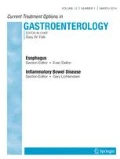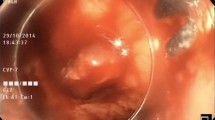Opinion statement
The Mallory-Weiss tear (MWT) is a frequent cause of upper gastrointestinal bleeding. It has been diagnosed more frequently since endoscopy was introduced. Once the diagnosis has been made, several treatment options are available. The treatment modality chosen depends on the type and location of the lesion, the patient’s comorbid conditions, the availability of the different therapeutic modalities, and the experience of the endoscopist with each of these different modalities. In general, if the MWT is not actively bleeding at the time of endoscopy, no further treatment is needed owing to a low risk of rebleeding, unless a visible vessel is present. In the presence of a visible vessel or an actively bleeding vessel, then we recommend the use of any of the endoscopic treatment modalities discussed later in this article depending on the patient’s condition and clinical scenario. Our review of the literature suggests that multipolar electric coagulation (MPEC) is the treatment modality with better evidence-based support for safety and bleeding control. MPEC has been associated only with very few complications. It should be avoided when esophageal varices are suspected because it may precipitate and aggravate bleeding. In such instances, either polidocanol injection or endoscopic band ligation of the tear is recommended, which is emerging as a safe and effective treatment modality even in patients without varices. In addition, epinephrine injection is an effective first-line modality. However, it should be avoided in patients with history of coronary artery disease owing to the potential for systemic absorption. Endoscopic hemoclipping (EH) is another useful treatment option and is emerging as a first-line modality. However, it is not widely available in all endoscopy emergency units. If it is available, it is a great alternative. Finally, if bleeding continues or recurs despite endoscopic therapy, the patient should be referred for surgical treatment. However, if the patient is not a surgical candidate, then radiologic hemostasis with selective vasopressin or Gelfoam embolization represents a viable treatment alternative that may be used depending on availability of a specialized interventional radiologist.
Similar content being viewed by others
References and Recommended Reading
Katz P, Salas L: Less frequent causes of upper gastrointestinal bleeding. Gastroenterol Clin North Am 1993, 22:875.
Quincke H: Ulcus oesophagi ex digestion. Dtsch Arch Kin Med 1879, 24:72.
Mallory GK, Weiss S: Hemorrhages from lacerations of the cardiac orifice of the stomach due to vomiting. Am J Med Sci 1929, 178:506–512.
Harris J, Dipalma J: Clinical significance of Mallory-Weiss tears. Am J Gastroenterol 1986, 88:2056–2058.
Sugawa C, Nenishek D, Walt A: Mallory-Weiss syndrome: a study of 224 patients. Am J Surgery 1983, 145:30–33. This is the largest series of patients with MWT published. It provides ample information on epidemiology, diagnosis, treatment, and outcomes in patients with MWT.
Younes Z, Johnson D: The spectrum of spontaneous and iatrogenic esophageal injury. J Clin Gastroenterol 1999, 29:306–317.
Michel L, Serrano A, Malt R: Mallory-Weiss syndrome. Ann Surg 1980, 192:716–721.
Baker R, Spiro A, Trnka Y: Mallory-Weiss tear complicating upper endoscopy. Gastroenterology 1982, 82:140–142.
Vries A, vander Maaten J, Laurens R: Mallory-Weiss tear following cardiac surgery: transesophageal echoprobe or nasogastric tube? Br J Anesth 2000, 84:646–649.
Paquet K, Mercado-Diaz M, Kalk J: Frequency, significance and therapy of the Mallory-Weiss syndrome in patients with portal hypertension. Hepatology 1990, 11:879–883.
Schuman B, Threadgill T: The influence of liver disease and portal hypertension on bleeding in Mallory-Weiss syndrome. J Clin Gastroenterol 1994, 18:10–12.
Bharucha A, Gostout C, Balm R: Clinical and endoscopic risk factors in the Mallory-Weiss syndrome. Am J Gastroenterol 1997, 92:805–808.
Kortas D, Haas L, Simpson W, Nickl N, Gates L: Mallory-Weiss tear: predisposing factors and predictors of a complicated course. Am J of Gastroenterol 2001, 96:2863–2865.
Llach J, Elizalde I, Guevara C, et al.: Endoscopic injection therapy in bleeding Mallory-Weiss syndrome: a randomized controlled trial. Gastrointest Endosc 2001, 54:679–681. This is one of the few recent randomized control trial on a therapeutic option for MWT.
Bataller R, Llach J, Salmero J, et al.: Endoscopic sclerotherapy in upper gastrointestinal bleeding due to Mallory-Weiss syndrome. Am J Gastroenterol 1994, 89:2147–2150.
Peng C, Tung C, Chow W, et al.: Efficacy of Endoscopic isotonic saline epinephrine injection for the for the management of active MWT. J Clin Gastroenterol 2001, 32:119–122.
Sugawa C, Fujita Y, Ikeda T, Walt A: Endoscopic hemostasis of bleeding of the upper gastrointestinal tract by local injection of 98% dehydrated ethanol. Surg Gynecol Obstet 1986, 162:159–163.
Stevens P, Lebwohl O: Hypertensive emergency and ventricular tachycardia after endoscopic epinephrine injection of a Mallory-Weiss tear. Gastrointest Endosc 1994, 40:77–78.
Laine L: Multipolar electrocoagulation in the treatment of active upper gastrointestinal tract hemorrhage. N Engl J Med 1987, 316:1613–1617.
Matsui S, Kamisako T, Kudo M, Inoue R: Endoscopic band ligation for control of nonvariceal upper GI hemorrhage: comparison with bipolar electrocoagulation. Gastrointest Endosc 2002, 55:214–218.
Myung S, Kim H, Moon Y: Severe Mallory-Weiss tear after endoscopy treated by endoscopic band ligation. Gastrointest Endosc 2000, 52:99–101.
Terada R, Ito S, Akama F, et al.: Mallory-Weiss syndrome with severe bleeding: treatment by endoscopic ligation. Am J Emerg Med 2000, 18:812–815.
Gunay K, Barbaros C, Ertekin T: Endoscopic ligation for patients with active bleeding Mallory-Weiss tears. Surg Endosc 2001, 15:1305–1307.
Yamaguchi Y, Yamato T, Katsumi N, et al.: Endoscopic hemoclipping for upper GI bleeding due to Mallory-Weiss syndrome. Gastrointest Endosc 2001, 53:427–430. This is the first trial that evaluated the use of endoscopic hemoclipping as a new treatment modality in patients with MWT.
Huang S, Wang H, Lee Y, et al.: Endoscopic hemoclip placement and epinephrine injection for Mallory-Weiss with active bleeding. Gastrointest Endosc 2002, 55:842–846. This trial has been the largest to examine the use of endoscopic hemoclipping.
Nusbaum M, Baum S: Radiographic demonstration of unknown sites of gastrointestinal bleeding. Surg Forum 1963, 14:374–375.
Robinette C, Gerlock J: Intra-arterial vasopressin infusion in treating acute gastrointestinal bleeding. South Med J 1980, 73:209–213.
Clark R: Intra-arterial vasopressin infusion for treatment of Mallory-Weiss tears of the esophagogastric junction. Am J Roentgengol 1979, 133:449–451.
Lieberman D, Keller F, Katon R, Rosch J: Arterial embolization for massive upper gastrointestinal tract bleeding in poor surgical candidates. Gastroenterology 1984, 86:876–885.
Carsen G, Casarella W, Spiegel R: Transcatheter embolization of Mallory-Weiss tears of the esophagogastric junction. Radiology 1978, 128:309–313.
Pezzulli F, Purnell F, Dillo E: The Mallory-Weiss syndrome: case report on embolization versus intrarterial vasopressin result. N Y State J Med 1986, 866:312–314.
Fisher R, Schwartz J, Graham D: Angiotherapy with Mallory-Weiss tear. Am J Roentgengol 1980, 134:679–684.
Welch G, McArdle C, Anderson J: Balloon tamponade for the control of Mallory-Weiss haemorrhage in patients with coagulation defects. Br J Surg 1987, 74:610–611.
Author information
Authors and Affiliations
Rights and permissions
About this article
Cite this article
Morales, P., Baum, A.E. Therapeutic alternatives for the Mallory-Weiss tear. Curr Treat Options Gastro 6, 75–83 (2003). https://doi.org/10.1007/s11938-003-0036-3
Issue Date:
DOI: https://doi.org/10.1007/s11938-003-0036-3




